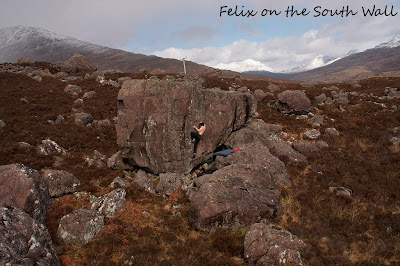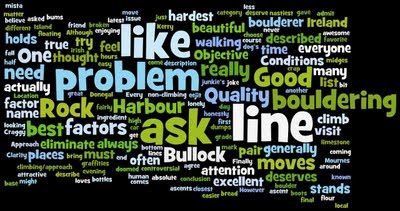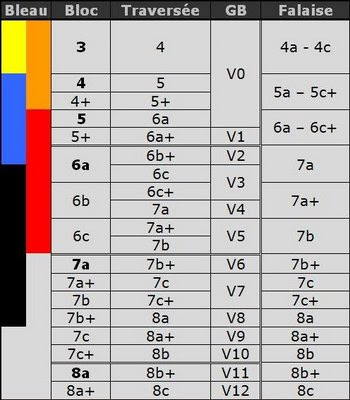
I bought
John Watson’s guide last year, and since I first opened it, I have been dying to visit Torridon. Unfortunately every time I planned to go, something went wrong. This time it was supposed to be the weather.
That was without taking into account the dedication of the stubborn boulderer that we can sometimes be. A week ago, Felix and I had planned to leave on Friday and be back on Saturday night, even though the forecast was not great: -3 degrees feeling like -18 in the wind above 700m, bands of snow coming from the north-west, freezing above 300 meters... Don’t check the
Scotland mountain weather forecast, it really puts you off.
We left at 2 o’clock and arrived around 7ish. Considering we stopped in an Agatha Christy style empty hotel (Murder in the Highlands) for a burger that was as tough as leather (the murder weapon, served by a cross-eyed waiter), I considered this being a reasonable journey. However it was too late to go bouldering so we waited until the next morning.
We woke up under 3 inches of snow, and it did not seem to be getting any better. So after having checked that magnificent but wet
Ship boulder, we decided we would visit the other bouldering spots around and come back in the afternoon if the weather had improved.
Kishorn boulders

Kishorn was the only spot we visited that morning. By the time we were at the boulders, the sun was shining and the boulders were extra dry, which gave us our first taste of that awesome torridonian sandstone.
Although the place is well described in the guide, we managed to miss the first boulder (
Russell Boulder) and started the session on the
Kishorn boulder of which the south face provided good shelter, dry landing and a hard project that is not indicated in the guide: just right of
Kishorn Dyno is a little wall with a few fainted but brushed clean holds. I must say it looks more doable that it actually is and I reckon it must be harder than 7b.
The weather rapidly changed again and within seconds the sky was dark grey and it was snowing. But it lasted just a few minutes and only then we realised that these were cracking conditions as the rock stayed cool and dry thanks to the cold wind and bands of snow, while we

could enjoy the real warm sun in between.
Before going back to Torridon, we spent a bit more time in Kishorn, Felix more specifically on the
South wall of the
Swamp boulder and I on eliminating the foot jam and the juggy arête of
the Cave (I guess that makes it a completely different problem then....)
The best boulder problem in Scotland?
When we came back to Torridon, the
Ship boulder was a bit like in the picture of the guidebook: big, reddish, very dry and
Richie Betts was on a mission. Actually it was not
the Mission, but
Malcolm’s arête the very one line I was psyched for.
Richie and his mate Murdo seemed well equipped for the place. At first sight I knew these were not casual boulderers as both lads had come
in their wellies. Moreover they had placed a huge tarpaulin over the pond -yes, we are talking DWS here. This and a wood pallet strategically placed offered a perfect landing area when combined with a couple of pads. Clearly they had to be “locals”.

Still they seemed a bit surprised when they saw us coming and they probably thought we were a bit stupid -though clearly lucky- to have chanced that unsettled weather for a one day trip only. But they had no problem sharing their landing platform and after a few tries I finally got my reward: would it sound slutty to say that it was better than I had imagined?
I don't know if it was because of the extremely good conditions, because of the pond below or because of the broken hold, but one thing is for sure, it was a bit different from what I had expected and I think that the
picture in John's guide is actually misleading so I decided to do a bit of editing:

As Carrie Bradshaw usually puts it, I couldn’t help but wonder: what if
Malcolm’s Arête was the best boulder problem in Scotland? (Yes, I’ve watched it several times, my wife wouldn’t let go the remote control, what’s your excuse?) As a matter of fact, I asked the lads if this was indeed the best boulder in Scotland but they eluded the question. So I decided to apply
my 7 criteria and see how high it would rank:
Rock quality: Top quality sandstone with some pebble inclusions, behaving a bit like grit.
5/5
Approach: Although it is very close to the road, the place is a bog, so bring on the wellies.
4/5
Conditions: Ok, this one is very debatable. This is the highlands, so the weather is unpredictable. But that rock seems to dry fast and the big puddle at the bottom was actually constituting a great landing area once Richie had covered it with a tarpaulin.
3/5
 Line Clarity
Line Clarity: No discussion possible here.
5/5
Moves: Classic moves including both campusing and footwork, dyno and mantelshelf. The essence of bouldering...
5/5
Location: Well, just pick up any tourist information about the highlands, and you’ll know what I’m talking about...
5/5
Popularity: I may not be familiar enough with the Scottish bouldering scene to be able to judge, but the fact that we actually joined other people trying the line would lead me to think it is indeed a popular boulder. I also understand that the FA was sent by some dude called Malcolm Smith. Enough said.
5/5.
That’s a score of
32 out of 35, certainly a strong contender for the title of Best boulder problem in Scotland!
Most pictures are courtesy of Felix Davey.

"Dude check that boulder over there: it looks ace!"












